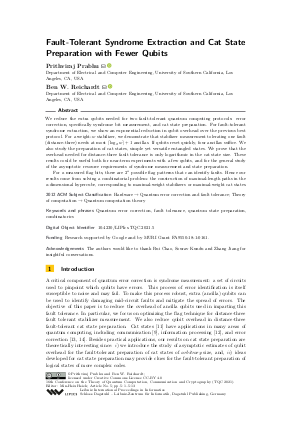Fault-Tolerant Syndrome Extraction and Cat State Preparation with Fewer Qubits
Authors
Prithviraj Prabhu  ,
Ben W. Reichardt
,
Ben W. Reichardt 
-
Part of:
Volume:
16th Conference on the Theory of Quantum Computation, Communication and Cryptography (TQC 2021)
Part of: Series: Leibniz International Proceedings in Informatics (LIPIcs)
Part of: Conference: Conference on the Theory of Quantum Computation, Communication and Cryptography (TQC) - License:
 Creative Commons Attribution 4.0 International license
Creative Commons Attribution 4.0 International license
- Publication Date: 2021-06-22
File

PDF
LIPIcs.TQC.2021.5.pdf
- Filesize: 8.91 MB
- 13 pages
Document Identifiers
Subject Classification
ACM Subject Classification
- Hardware → Quantum error correction and fault tolerance
- Theory of computation → Quantum computation theory
Keywords
- Quantum error correction
- fault tolerance
- quantum state preparation
- combinatorics
Metrics
- Access Statistics
-
Total Accesses (updated on a weekly basis)
0Document
0Metadata
Abstract
We reduce the extra qubits needed for two fault-tolerant quantum computing protocols: error correction, specifically syndrome bit measurement, and cat state preparation. For fault-tolerant syndrome extraction, we show an exponential reduction in qubit overhead over the previous best protocol. For a weight-w stabilizer, we demonstrate that stabilizer measurement tolerating one fault (distance-three) needs at most ⌈ log₂ w ⌉ + 1 ancillas. If qubits reset quickly, four ancillas suffice. We also study the preparation of cat states, simple yet versatile entangled states. We prove that the overhead needed for distance-three fault tolerance is only logarithmic in the cat state size. These results could be useful both for near-term experiments with a few qubits, and for the general study of the asymptotic resource requirements of syndrome measurement and state preparation. For 'a' measured flag bits, there are 2^a possible flag patterns that can identify faults. Hence our results come from solving a combinatorial problem: the construction of maximal-length paths in the a-dimensional hypercube, corresponding to maximal-weight stabilizers or maximal-weight cat states.
Cite As Get BibTex
Prithviraj Prabhu and Ben W. Reichardt. Fault-Tolerant Syndrome Extraction and Cat State Preparation with Fewer Qubits. In 16th Conference on the Theory of Quantum Computation, Communication and Cryptography (TQC 2021). Leibniz International Proceedings in Informatics (LIPIcs), Volume 197, pp. 5:1-5:13, Schloss Dagstuhl – Leibniz-Zentrum für Informatik (2021)
https://doi.org/10.4230/LIPIcs.TQC.2021.5
BibTex
@InProceedings{prabhu_et_al:LIPIcs.TQC.2021.5,
author = {Prabhu, Prithviraj and Reichardt, Ben W.},
title = {{Fault-Tolerant Syndrome Extraction and Cat State Preparation with Fewer Qubits}},
booktitle = {16th Conference on the Theory of Quantum Computation, Communication and Cryptography (TQC 2021)},
pages = {5:1--5:13},
series = {Leibniz International Proceedings in Informatics (LIPIcs)},
ISBN = {978-3-95977-198-6},
ISSN = {1868-8969},
year = {2021},
volume = {197},
editor = {Hsieh, Min-Hsiu},
publisher = {Schloss Dagstuhl -- Leibniz-Zentrum f{\"u}r Informatik},
address = {Dagstuhl, Germany},
URL = {https://drops.dagstuhl.de/entities/document/10.4230/LIPIcs.TQC.2021.5},
URN = {urn:nbn:de:0030-drops-140001},
doi = {10.4230/LIPIcs.TQC.2021.5},
annote = {Keywords: Quantum error correction, fault tolerance, quantum state preparation, combinatorics}
}
Author Details
- Department of Electrical and Computer Engineering, University of Southern California, Los Angeles, CA, USA
Funding
Research supported by Google and by MURI Grant FA9550-18-1-0161.
Acknowledgements
The authors would like to thank Rui Chao, Sourav Kundu and Zhang Jiang for insightful conversations.
References
- Christopher Chamberland and Michael E. Beverland. Flag fault-tolerant error correction with arbitrary distance codes. Quantum, 2:53, 2018. URL: https://doi.org/10.22331/q-2018-02-08-53.
- Christopher Chamberland, Aleksander Kubica, Theodore J. Yoder, and Guanyu Zhu. Triangular color codes on trivalent graphs with flag qubits. New Journal of Physics, 22(2):023019, 2020. URL: https://doi.org/10.1088/1367-2630/ab68fd.
- Christopher Chamberland, Guanyu Zhu, Theodore J. Yoder, Jared B. Hertzberg, and Andrew W. Cross. Topological and subsystem codes on low-degree graphs with flag qubits. Phys. Rev. X, 10:011022, 2020. URL: https://doi.org/10.1103/PhysRevX.10.011022.
- Rui Chao and Ben W. Reichardt. Error correction with only two extra qubits. Phys. Rev. Lett., 121:050502, 2018. URL: https://doi.org/10.1103/PhysRevLett.121.050502.
- Rui Chao and Ben W. Reichardt. Fault-tolerant quantum computation with few qubits. npj Quantum Information, 4(1):42, 2018. URL: https://doi.org/10.1038/s41534-018-0085-z.
- Rui Chao and Ben W. Reichardt. Flag fault-tolerant error correction for any stabilizer code. PRX Quantum, 1:010302, 2020. URL: https://doi.org/10.1103/PRXQuantum.1.010302.
- David P. DiVincenzo and Panos Aliferis. Effective fault-tolerant quantum computation with slow measurements. Phys. Rev. Lett., 98:220501, 2007. URL: https://doi.org/10.1103/PhysRevLett.98.020501.
-
M. Gardner. The Binary Gray Code. In Knotted Doughuts and other Mathematical Entertainments, pages 22-39. W. H. Freeman and Company, New York, 1986.

- Nicolas Gisin and Rob Thew. Quantum communication. Nature Photonics, 1(3):165-171, 2007. URL: https://doi.org/10.1038/nphoton.2007.22.
- F. Gray. Pulse code communication, 1953. US Patent 2,632,058. URL: http://www.google.com/patents/US2632058.
- Daniel M. Greenberger, Michael A. Horne, and Anton Zeilinger. Going Beyond Bell’s Theorem, pages 69-72. Springer Netherlands, Dordrecht, 1989. URL: https://doi.org/10.1007/978-94-017-0849-4_10.
- Jian-Wei Pan, Zeng-Bing Chen, Chao-Yang Lu, Harald Weinfurter, Anton Zeilinger, and Marek Żiukowski. Multiphoton entanglement and interferometry. Rev. Mod. Phys., 84:777-838, 2012. URL: https://doi.org/10.1103/RevModPhys.84.777.
- Peter W. Shor. Fault-tolerant quantum computation. In Proc. 37th Symp. on Foundations of Computer Science (FOCS), page 96, 1996. URL: https://doi.org/10.1109/SFCS.1996.548464.
- Andrew M. Steane. Active stabilization, quantum computation, and quantum state synthesis. Phys. Rev. Lett., 78(11):2252-2255, 1997. URL: https://doi.org/10.1103/PhysRevLett.78.2252.
- Ashley M. Stephens. Efficient fault-tolerant decoding of topological color codes, 2014. URL: http://arxiv.org/abs/1402.3037.
- Theodore J. Yoder and Isaac H. Kim. The surface code with a twist. Quantum, 1:2, 2017. URL: https://doi.org/10.22331/q-2017-04-25-2.
